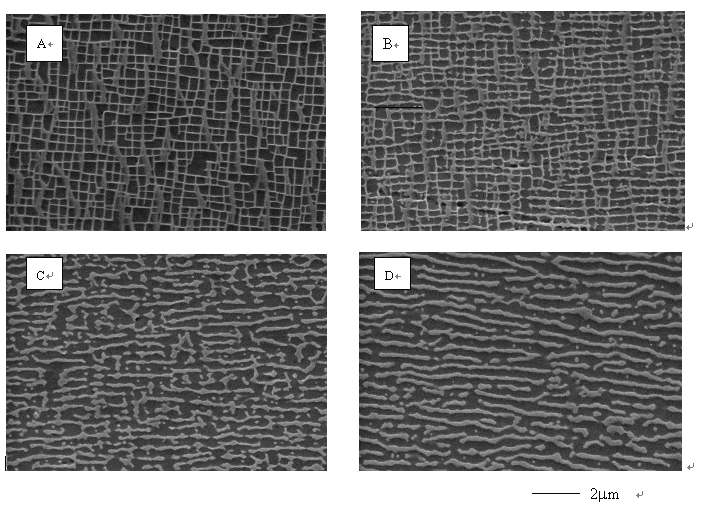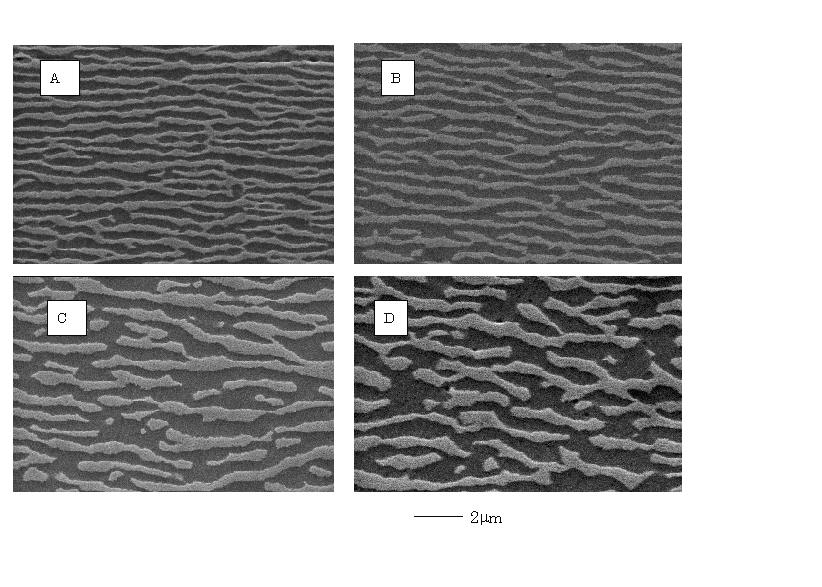

Microstructure Analysis Team and *Ni-base Superalloy Team High Temperature Materials 21 Project
National Research Institute for Metals (NRIM) 1-2-1 Sengen Tsukuba-shi, Ibaraki 305-0047 Japan
The high temperature mechanical behaviour of nickel base superalloys mainly depends on the reinforcing Gamma' precipitate, and the evolution of such morphology strongly depends on the applied stress and temperature. In particular single crystal nickel base superalloys, with a large fraction of hardening cuboidal Gamma' having a negative misfit, if creep tested under tensile load along <001> crystalline direction at high temperature, can produce a lamellar Gamma/Gamma' pattern perpendicular to the loading axis.
At intermediate temperatures, around 900C, the rafted microstructure can develop throughout a considerable portion of the creep life, and the maximum extension of the lamellar structure is generally obtained during the tertiary creep. At T > 1000C this peculiar microstructure builds up very quickly, during the primary stage and the rafted Gamma' microstructure is present for practically all the creep life.
The objective of this paper is to critically show the preliminary results of an ongoing research on the effect of the Gamma' morphology evolution on the creep strain rate behaviour at 900C and 1100C on TMS 75 [1], a third generation, rhenium containing alloy developed by NRIM, Tsukuba, Japan, for single crystal turbine blade and vane applications. The former studied temperature is of paramount importance for land base gas turbines; the latter is more related to high performance aeronautical engines.
The knowledge of the Gamma' morphology effect on the high temperature mechanical behaviour, is of great importance both for developing new alloys to be utilized in single crystal components, and to improve methodologies able to predict service life of such critical components [2], ensuring their more efficient use.
The experimental creep curve obtained at 900(C/392MPa is plotted in Fig. 1 as e vs. t and log(de/dt) vs. t.
The creep curve of TMS 75 single crystal alloy, at 900C, exhibits a short and small primary stage and the majority of the single creep curves consist of tertiary creep. The results are consistent with those obtained on CMSX-4 [3] and on other single crystal nickel base superalloys [4,5] for equivalent applied stresses/temperatures.
The plot log(de/dt) vs. t clearly shows two different rates of damage accumulation during tertiary creep.
The first tertiary creep stage starts after the minimum creep rate, and it influences the creep curve up to 2.45% of strain. A rapid decreasing of the curve slope demarcates the beginning of the second stage of the tertiary creep, during which most of the creep strain is accumulated.
During the last portion of the creep curves, fracture mechanisms, e.g. crack propagation and/or localized reduction of area, produce a further increment of the creep strain rate up to the final fracture. The plots of Figs. 1 clearly show that the contribution of the fracture mechanisms happens at the last end of the creep test.
Figs. 2 show typical SEM micrographs of the Gamma/Gamma' microstructure obtained from longitudinal sections of specimens after interrupted creep at the times corresponding to the arrows in Fig. 1.
The micrographs show that the rafted-like microstructure shapes up during the first stage of the tertiary creep, between point B and C in Fig. 1. During this stage, the thickness of the horizontal Gamma channels, perpendicular to the applied stress, show a remarkable increment.
The microstructure observed at e = 13% (D) shows no substantial difference compared to the previous microstructure (C), in particular the horizontal ( channels show only a small increment in the thickness although about 10% of strain was accumulated from the point C.
The higher damage rate accumulation during the first stage of the tertiary creep appears to be attributed to formation of the lamellar Gamma/Gamma' structure.
A correlation between strain rate and horizontal Gamma channel thickness for the single crystal CMSX4 can be found in [6,7].
The experimental creep curve, performed at 1100C, 137MPa, and the evolution of the Gamma/Gamma' microstructure are shown respectively in Figs. 3 and 4.
The lamellar Gamm/Gamma' microstructure is already well developed at the end of the primary stage. The creep curve is characterized by a long pseudo steady state, where the creep strain rate increases very slowly. During this period the raft structure progressively coarsens. At the end of this period the strain rate enhances markedly without the Gamma/Gamma'microstructure showing clear modifications. No cracks were detected in the specimen strained up to the point D to justify the increment of the creep rate.
1. Koizumi Y. et al., Proc. Conf. Materials for Advanced Power Engineering 1998, ed. J. Lecomte et al., Forschungzentrum, Julich, p.1089, (1988).
2. T. Yoshida et al., in this proceeding.
3. Henderson PJ, Lindblom J, Scripta Mater., 37, 491 (1997).
4. Maldini M, Lupinc V., Proc. Conf. Strength of Materials, ed. by H. Oikawa et al., Japan Institute of Metals, Sendai, p.697 (1994).
5. Maldini M, Lupinc V., Materials at High Temp., 14, 47 (1997).
6. Peng. Z et al, Scripta Mater., 34, 221 (1996).
 | 
|
Fig 1 Plots of e vs t and log(e) vs t of a creep tests at 900C/392 MPa.

Fig. 2 SEM microstructure of longitudinal sections corresponding to the point A, B, C and D of the creep curve of Fig. 1. All the photos have the same magnification.
 | 
|
Fig 3 Plots of e vs t and log(e) vs t of a creep tests at 1100C/137 MPa.

Fig. 4 SEM microstructure of longitudinal sections corresponding to the point A, B, C and D of the creep curve of Fig. 3. All the photos have the same magnification.